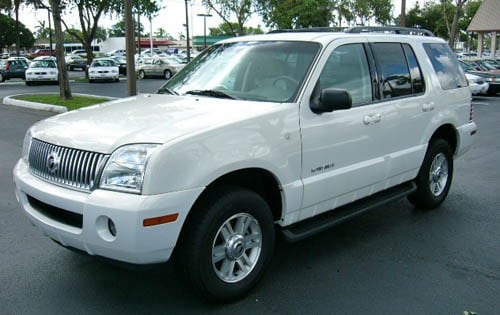2004 Mercury Mountaineer Transmission Problems/Repair Costs/Fluid
Last Updated on October 5, 2022 by Robert Wilson
2004 Mercury Mountaineer Transmission Problems The 2004 Mercury Mountaineer has a major transmission problem that has been affecting many drivers. The main issue is that the transmission will randomly slip out of gear while driving, which can obviously be very dangerous.
This has been happening more and more often, and Ford (the company who owns Mercury) has yet to find a fix for the problem. Many people have had to get their transmissions completely replaced, which is obviously a huge expense. Ford needs to take responsibility for this serious safety issue and come up with a solution ASAP.
2004 Mercury Mountaineer Transmission Problems
We have all heard about the 2004 Mercury Mountaineer transmission problems. The question is, what are they?
Here is a list of some of the most common ones:
1) Delayed or uneven shifting – This can be caused by a number of things, but most likely it is due to low transmission fluid levels or dirty transmission fluid. Either way, it needs to be checked and fixed as soon as possible.
2) Hard shifting – Again, this can be caused by several things but dirty transmission fluid is usually the culprit. Have your local mechanic check it out and flush the system if necessary.
3) Slipping transmission – This is a serious problem that needs to be addressed immediately.
It could be caused by low fluid levels, worn clutch plates, or even internal damage to the transmission itself. Get it checked out right away!
Transmission Problems (Mountaineer/Explorer)
What are Early Signs of Transmission Failure?
There are several early signs of transmission failure. The most common is a grinding or whining noise coming from the transmission area. This noise is usually caused by a lack of lubrication in the system, and it can indicate that the transmission is not getting enough fluid.
Another common sign of transmission failure is slipping. This occurs when the transmission cannot engage properly, and the car will move forward even though the gearshift is in neutral. Finally, Transmission failures can also cause vibration, which is often felt through the steering wheel or seat.
What is the Most Common Cause of Transmission Failure?
There are many possible causes of transmission failure, but the most common is probably due to a lack of proper maintenance. Without regular servicing, transmissions can overheat and break down. Other causes of transmission failure include poor quality fluid, worn-out parts, and improper installation.
What are the Most Common Transmission Problems?
There are a number of different transmission problems that can occur, and the most common will vary depending on the vehicle. In general however, the three most common transmission problems are slipping, leaking and shifting issues.
Slipping is when the transmission fails to engage or disengage properly, causing the car to move even when it’s in park or neutral.
This can be caused by a number of things including low fluid levels, worn clutches or a faulty solenoid.
Leaking is pretty self explanatory- it’s when fluid leaks from the transmission. This can be due to a hole or crack in the casing, loose seals or gaskets or simply old age/wear and tear.
Shifting issues cover a wide range of potential problems, but generally speaking it means that the gears aren’t engaging correctly or at all. This could be because of low fluid levels, worn parts, damaged solenoids or an issue with the computer system.
These are just some of the potential transmission problems that can occur- if you think you may be experiencing any sort of issue it’s always best to get it checked out by a professional as soon as possible to avoid further damage!
How Do You Check the Transmission Fluid on a Mercury Mountaineer?
To check the transmission fluid on your Mercury Mountaineer, you will need to locate the dipstick. The dipstick is usually located near the front of the engine bay, on the passenger side. Once you have located the dipstick, pull it out and wipe it clean with a rag.
Then, reinsert the dipstick all the way back into its housing.
Next, remove the dipstick again and check the level of fluid on it. The fluid should be at or just below the “Full” line on the dipstick.
If it is not, then you will need to add more transmission fluid until it reaches that level. To do so, simply pour transmission fluid into the opening where you removed the dipstick from.
It is important to check your transmission fluid regularly in order to keep your vehicle’s transmission in good working condition.
If you let the fluid get too low, it can cause damage to your transmission.

Credit: www.edmunds.com
2004 Mercury Mountaineer Transmission Replacement Cost
The average cost for a Mercury Mountaineer transmission replacement is between $3,060 and $3,619. This estimate does not include taxes or fees. The parts and labor required for this service are also shown in this blog post.
Most Common 2004 Mercury Mountaineer Transmission Failures

- Lack of Response
- Leaking Fluid
- Low Fluid
- Burning Smell
- Grinding or Shaking
- Gears Slipping
(2004 Mercury Mountaineer) Transmission Fluid Change (Video)
(2004 Mercury Mountaineer) Transmission OIL Change (Video)
Conclusion
The Mercury Mountaineer has been known to have transmission problems, especially in the 2004 model. The most common issues are with the shifting, as the gears will either get stuck or slip. This can be extremely dangerous, as it can cause the vehicle to stall in traffic or even lose control.
There have been reports of this happening at high speeds, which can obviously lead to accidents. Mercury has issued a recall for this problem and will fix it free of charge, but many people have had to pay out of pocket to get their transmission repaired.
